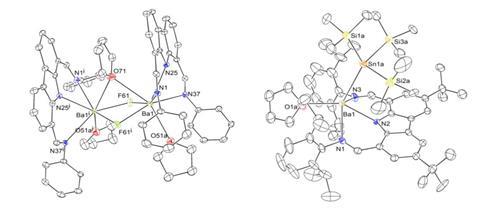Ligand tames barium, making precursor to first barium–tin and first molecular barium–fluorine bond
A custom-made ligand has unlocked barium’s organometallic chemistry, including the first molecular barium fluoride and the first molecule with a barium–tin bond.
Molecular heavy alkaline earth metals such as calcium can replace expensive transition metal catalysts in common transformations and make some unusual reactions happen. But since these metals are quite reactive – preferring to form strongly ionic bonds – accessing their organometallic compounds requires some chemical convincing.
For calcium and strontium, chemists’ go-to ligand is a bulky diketimine. But with barium, the ligand produces a stable but chemically uninteresting salt. Because of this, molecular compounds of barium are almost entirely unknown.
Researchers in France have now designed a bulky carbazole ligand that they call the ‘master key for barium chemistry’. It allowed the team to synthesise a host of stable organometallics, like a barium–fluorine and a barium–tin compound – both of which are firsts.

The ligand itself is made in a few steps on a multigram scale. Combined with a barium compound it forms a yellow complex that is stable for at least 20 days when heated to 60°C in benzene. The unusual stability is likely the result of the ligand’s shape, which fits the barium atom like a glove, providing a sheltered coordination sphere.
This compound is not only a good precursor for other molecular barium compounds, it is also a record-breaking catalyst. In the hydrophosphination of styrene, it achieves a higher turnover frequency at a lower temperature than the next best catalyst, a calcium complex.
In a reaction with trimethyltin fluoride, the precursor is converted into a molecule in which two fluorine atoms bridge two barium centres. The chemists also used the ligand to create the first barium–tin bond and the second-ever barium–silicon bond.
The team hopes that their carbazole ligand will prove as popular among researchers working with barium as the diketimine has with calcium chemists.
References
P M Chapple et al, Angew. Chem. Int. Ed., 2020, DOI: 10.1002/anie.202001439












1 Reader's comment